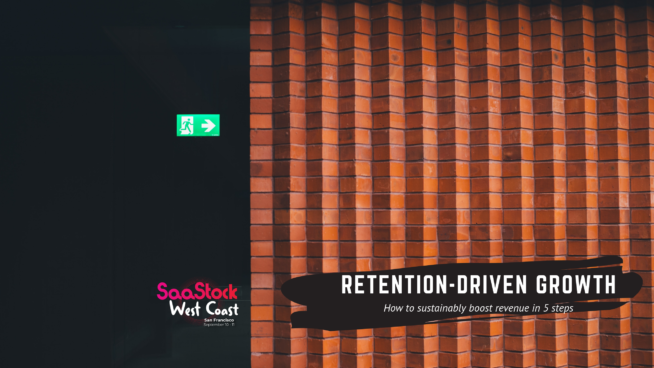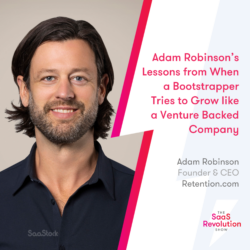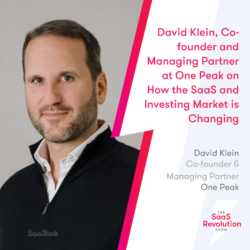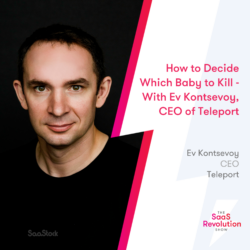This is a guest post by Guy Marion, Co-founder and CEO of Brightback about retention-driven growth. Guy is one of many excellent speakers we will host at SaaStock West Coast, taking place September 10-11. Grab an early bird ticket (our best possible price) before Friday, July 19th to see him and over 30 other incredible speakers.
Many SaaS and subscription companies are addicted to acquisition. Leads, trials and conversions are sexy metrics. But the reality is that if you’re not retaining customers, growth fizzles out.
So, how can companies grow sustainably? The answer lies in churn (seriously).
Churn represents a company’s failure to deliver on the desired outcome of a product or service—the ideal customer experience hasn’t been realized. There’s a big opportunity here for companies to learn, improve and ultimately retain more of their customers they worked so hard to acquire.
The following 5 steps outline how companies can engage with customers before they walk out the door. And why doing so can be the key to unlocking retention-driven griwth, a hidden growth lever you’ve been looking for.
Retention-driven growth starts with a conversation at cancellation
Cancellation is the most valuable moment in the customer lifecycle rivaled only by the moment of purchase, but it’s a blindspot for most companies. When customers cancel, they’re sending you a message with their wallets, but it’s a message many companies don’t take the time to understand.
Talking with every customer who cancels will arm you with the insights you need to improve your product, but only if it’s classified in a systematic way.
One is to build an exit survey that’s served up to every customer canceling their account is critical. Taking a basic approach may look like building out a survey flow using SurveyMonkey or Qualtrics. Alternatively, you could create a custom survey that’s a part of your web experience.
A step further is to be proactive about it and use a product that identifies at-risk customers and serves up a personalized cancel experience based on customer segmentation, like plan type, billing details, etc. This is ideal if you want to automate the retention process (e.g. reaching out to customers or alerting the right teams) and save engineering resources related to building and integrating survey data. That is what Brightback is focused on building.
Define your churn
Now that you’re surveying your customers at the point of cancel and collecting feedback, it’s time to organize the reasons for cancelling into categories. When defining categories, consider who is influenced by the feedback. Ask yourself: What actions will you be taking as a result of this information? Think of objectives like product, pricing and customer experience.
Start by adding an open ended question in your exit survey. Ask the customer to identify in their own words why they are canceling their account. This will be qualitative data, but as the answers are captured, you can begin to summarize reasons, surface common themes and later prompt customers to choose reasons from a list.
Reason-based classification has three major benefits for companies:
- Everyone in the company speaks the same language about churn, and you can revisit the reasons people cancel again and again for new insights.
- It’s easier to identify what parts of the business are in need of investment in order to grow retention.
- You can assess the efforts and investments made over time are having an impact on churn, especially when the data is reviewed in cohorts.
Everyone will look at their churn data differently, but will most likely come to the same conclusions about reasons and categories. Generally, these categories look the same across business types and industries.
Build segmentation around actionability
Actionability is about understanding that the customer is in control, and that customers have unique needs that you can meet, if you engage within the right context. Segmenting churn by actionability allows you to funnel resources to customers that are likely to respond, and learn from the ones that don’t. There’s a couple ways to look at actionability.
Influenceable v. non-influenceable
One approach is determining whether the customer would churn if you were to satisfy unmet needs. This is referred to as influenceable vs. non-influenceable churn.
Examples of influenceable churn:
- Misunderstood product
- Poor onboarding
- Mismatch of value for cost
- New stakeholder or executive owning services
- Poor overall customer experience
And non-influenceable:
- Poor performance
- Security incident
- Company failure
- Downsized or exceeded, especially if price changed
- Changing business model or company strategy
- Mistake purchase
Voluntary v. involuntary churn
A different approach would be looking at churn as voluntary or involuntary. Voluntary churn happens when the customer actively chose to leave, meaning they hit the cancel button or contacted support to initiate cancellation. Involuntary churn is generally related to payment problems like expired credit cards.
Offer customers to stay
Actionability only works if you provide an offer to a customer on the right channel, at the right time for the right reason. Doing this gives your customers a way to stay, and our data shows that 15% of customers will do so.
Offers should look different based on the combination of customer data, the reason for cancel and the objective for outreach.
- Discount pricing
- A meeting with an internal leader
- The ability to downgrade or pause account
- Onboarding material
- Training videos
- Chat with support
As you track the effectiveness of your offers based on cohort data, you can identify the highest opportunity for actionability and eliminate those that don’t retain customers.
Optimize for saved revenue
Customers that accept offers and decide not to cancel are directly attributable as saved revenue. And this can mean big things for your bottom line; customers continue to generate more saved revenue the longer they continue to subscribe.
As such, your strategy should be tested and optimized like any other revenue generating activity. Here’s where you should be gathering data and making changes to increase saved revenue:
- Survey copy: use dynamic fields to personalize names, companies or attributes unique to your customers.
- Reasons for cancellation: isolate actionable from inactionable reasons, and track open ended comments to mine and explore new reasons.
- Segmentation: track actionability based on customer attributes like billing, tenure, value, and product usage.
- Offer strategy: define what offers (discounts, meetings, etc.) entice customers and ultimately lead them to stay.
- Engagement workflow: look for the outreach channels that are most effective.
- Product enhancements: find the patterns in customer feedback about your product and focus improvement there.
Retention-driven growth is within reach
Occasionally I’m asked if attempting to retain customers at the point of cancel is too late. Put simply: it’s not. Our data shows that anywhere from 15 to 30% of customers cancel their subscriptions citing the influenceable reasons outlined above. A significant portion of your customers don’t want to churn. Will you let them?
Guy Marionwill be joining us at SaaStock West Coast this September 10 – 11 in San Francisco. Grab an early bird ticket (our best possible price) before Friday, July 19th to see him and over 30 other incredible speakers.
About Guy Marion, Co-founder and CEO of Brightback
Guy Marion is Founder and CEO of Brightback, the first automated customer retention software for subscription businesses. Guy brings unique SaaS growth, product, and sales experience, from launch to $100M ARR to IPO. Prior to founding Brightback, Guy was an Entrepreneur In Residence (EIR) at Matrix Partners, Autopilot COO, Zendesk Head of Online Sales, CollabNet VP & GM, and CEO/growth at Codesion (acq. by CollabNet, 2010). He has a Ph.D. in the natural sciences, and enjoys hiking, sailing, and hanging with his wife and two kids.





